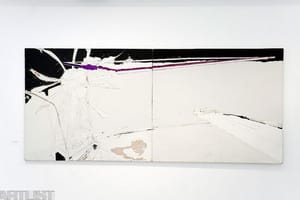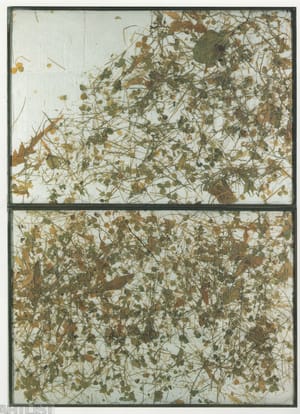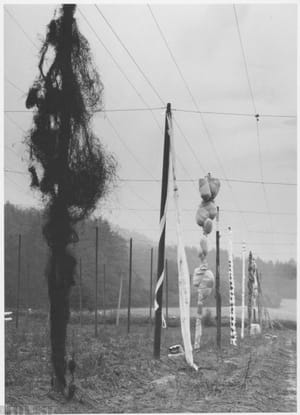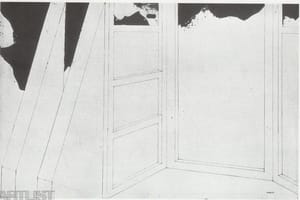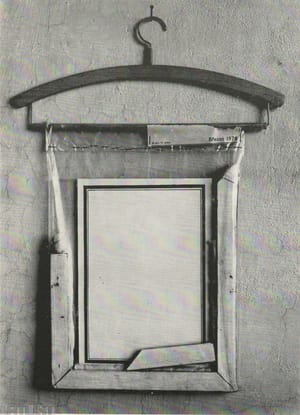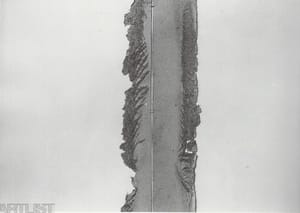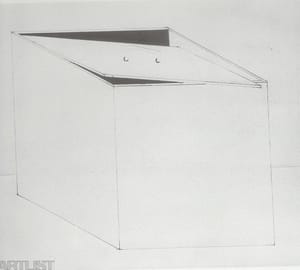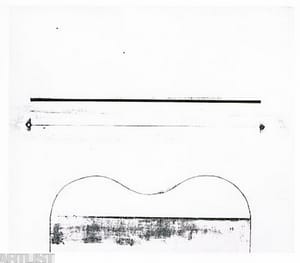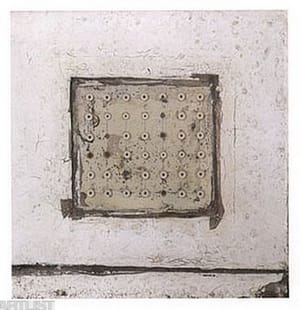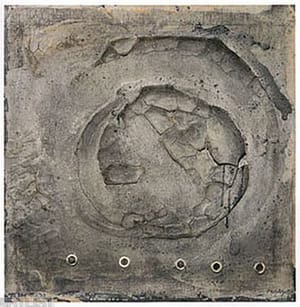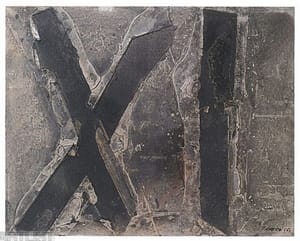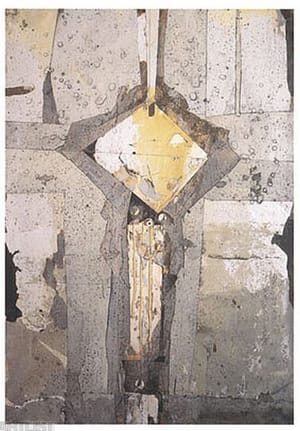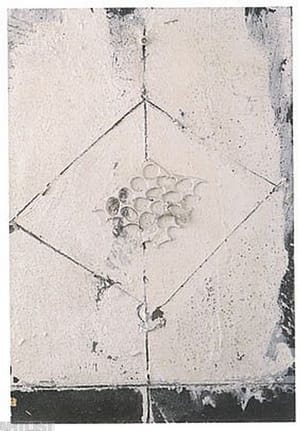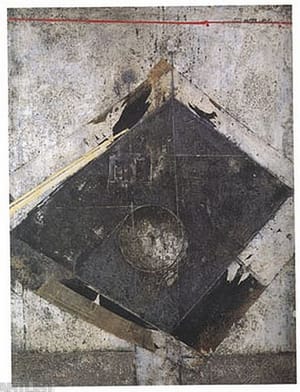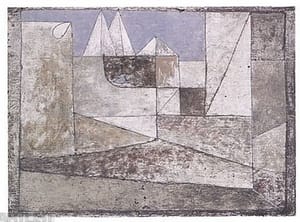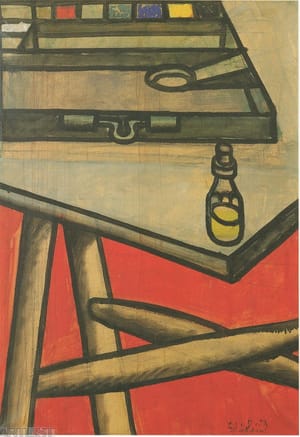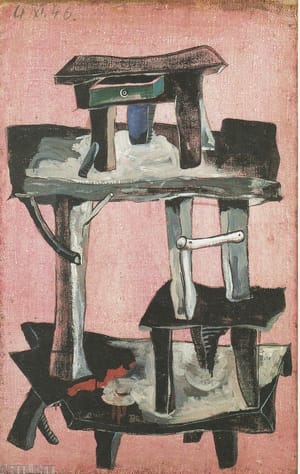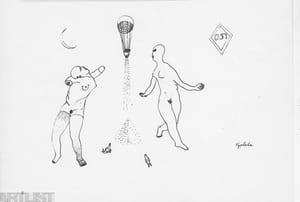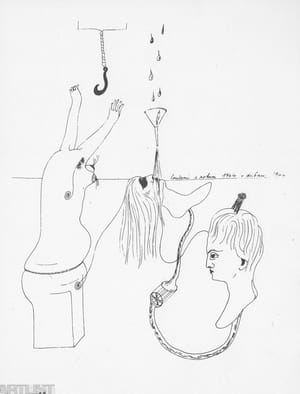- First Name
- Čestmír
- Surname
- Kafka
- Born
- 1922
- Birth place
- Jihlava
- Place of work
- Praha
- Died
- 1988
- Lived and worked in
- Praha
- Keywords
- CSU Library
- ↳ Find in the catalogue
About artist
Čestmír Kafka began his studies in art in 1940 at the School of Art in Zlín. His studies were interrupted when he was sent into forced labour (1942-43). He completed his education in 1945. He studied applied and decorative painting in architecture and advertising under Vladimír Hroch. Vincenc Makovský, known for his surrealist leanings, also taught at the school in Zlín. Kafka shared these leanings and his inclination in that direction was reinforced: in Zlín Kafka created numerous surrealist drawings, many of which resemble diary entries. He was also interested in literature, especially surrealist, and art theory. And he was politically active – attracted to this activity in part by his friendship with painter Václav Chad, who was shot by the Gestapo.
In 1946-1949 Kafka studied at the Academy of Arts, Architecture and Design in Prague under Emil Filla. Instruction in cubism introduced a new experience into the artist’s surrealist world. The earlier echoes of Picasso’s work (not just from his cubist period) began to mix with a rationally organised cubist articulation of the visual surface. Čestmír Kafka also went through a period of struggling to find a generational style, which was typical among students of art in that era. It was a time when the war had severed the natural course of artistic development, and when, after 1948, the dictatorship of Stalinist cultural ideology seized control. Most young artists then looked to pre-war trends for something to draw on. An example is Kafka’s painting Black Tables (Černé stoly, 1946), in which the artist put his surrealist-cubist lessons to use, and in which there is still a sense of a waning wartime gloom.
In the second half of the 1950s some artists began coming together in different art groups centred on a shared outlook. Čestmír Kafka was a member of the group Route 45 (Trasa 54), which had its first exhibition in 1957, and whose members included other graduates of Filla’s studio (E. Kmentová, J. Válová, K. Válová, O. Čechová, Z. Fibichová, V. Preclík, K. Vaca, O. Zoubek, Z. Šimek). This group espoused the aesthetics of the poetry of everyday life. Simple, informal modernism was interpreted as a reaction to the pathos of cliché images and the gestures of socialist realism so remote from real life. Kafka’s paintings from this period are expressively sober and gravitate towards a constructivist composition of the visual elements (Střechy, 1958; Velké střechy, 1960). The lessons of Paul Klee are deployed here, the inspiration for Kafka’s paintings with character-type stylisations or even abstract in tone (An Italian Town / Italské město, 1962).
In the 1960s Čestmír Kafka gravitated towards material ‘painting’. He applied thick layers of colour into which he mixed other elements and objects. Oil, plaster, enamel, sand, clay, glass, paper and other elements not usually used in painting were layered in various ways and their surfaces dug at and scratched to heighten the emotional component of the image. And he also devoted attention to the work’s geometric organisation. In the end the image is dominated by a graphic character (The Yellow Bride / Žlutá nevěsta, 1965). Here the artist showed his talent in two fields: he was someone who perceived the world sensitively and with poetic reflection, and he was also a person with a rationalist inclination. That aspect began to dominate in the late 1970s, though Kafka never became a constructivist artist in the pure sense. At the back of his work there are always what seem to be remote surrealist echoes from the early days of his journey. A painting was often sparked by a memory from his personal life, a landscape, or something he had experienced. And perhaps that is why we often have a sense of some mysterious code at play in Kafka’s work (Little Sheep Pen, White /Ovčinec, bílý, 1970).
There is also a strong imaginative feeling to paintings such as Measurement (Měření, 1970), the cycle Parting Cubes (Rozestupující se krychle, 1971) and Drawing for the Installation of a Piece of Equipment (Nákres k instalaci zařízení, 1972). In these works the expressive device is no longer the material but lines, seemingly marked out in black on a white base. Here Kafka was at his freest in the sense of minimising his devices. This is a direction of his work than runs right through the 1970s and extends even into the early 1980s (Window-Branišov / Okno-Branišov, 1977; Old Garden II / Stará zahrada II, 1984-86). The paintings capture the atmosphere of infinite timelessness, which can be interpreted as a statement of the artist’s feelings in the normalisation era. The world is colourless, figures illegible, spaces silent and empty. The illusionary-architectural images of a world without life testify to an existential experience of existence and pull us into the sphere of metaphysics, as a place of refuge from the sense of hopelessness at that time.
Along with these works on the philosophy of existence, from 1973 Kafka was creating objects that incarnated his faith in the expressive force of materials. This was the motivation for the cycles Piercing (Prorážení), Months (Měsíce) and On the Union of Two Things (O spojování dvou věcí), which continued into the 1980s and which the artist referred to familiarly as ‘connect-the-dot’ works. They have a diary-like quality to them (another link to surrealism). The artist covered the surface with various objects and connected them to each other in different ways. For Kafka connection was almost a ritual process, in which he comes to an awareness of himself. He would take remnants of clothes, used packaging, and other relics of the human world and cut and fold and sew and bind them together. These simple materials and the simple way in which they were worked evoke spirituality, an area Kafka was constantly drawn to as a place where it is possible to find meaning in life.
In the 1980s Kafka worked on the cycle Substances (Hmoty, 1983-84). He focused on creating intellectually more direct assemblages with a more material impression. The artist would loosely arrange natural materials (grass, ash, clay, roots, leaves) on a soft foundation of assembled padding and then press everything together beneath a transparent Plexiglas panel.
Although Kafka’s work had intellectual foundations, its source was his strong emotions. An interest in philosophical questions of existence (especially in the existential sense) was balanced by leanings towards simple, natural, everyday materials. The high points of Kafka’s work include his painted ‘white paintings’, filled with ethereal constructive elements, and his assemblage cycles, in which he made use of direct contact with the material. In both aspects we can see a metaphor for Kafka’s feelings and views in life, which constituted fusions of strong personal emotions amended by rationalism, and which at the same time were infused with ideas that sprang from the artist’s unconscious or his reflections on life.
- Author of the annotation
- Ivona Raimanová
- Published
- 2015
CV
Studies:
1945-1949 Academy of Applied Arts, Architecture and Design, Prague,
painting studio of Emil Filla
1940-1945 School of Arts, Zlín, Vladimír Hroch
1942-1943 forced labor in Styria
- Member of art groups included in ARTLIST.
Exhibitions
- Solo exhibitions
-
2008
Čestmír Kafka: Krajiny možného konání, Topičův salon (2007-), Praha
2005
Čestmír Kafka: Obrazy, monotypy, práce na papíře, Rožmberský dům, Soběslav
2002
Čestmir Kafka, Galerie Benedikta Rejta, Louny
1994
Čestmír Kafka: Obrazy, kresby, koláže, asambláže 1943 - 1988, Valdštejnská jízdárna, Praha
1989
Čestmír Kafka: Trojí poslední směřování, Galerie Nová síň, Praha
Čestmír Kafka: Kresby, obrazy, Galerie Benedikta Rejta, Louny
1988
Čestmír Kafka: Kresby a obrazy z let 1942 - 1947, Artotéka, Obvodní knihovna v Praze 4, Praha
1987
Čestmír Kafka: Spojování a archetypy, Sovinec, Sovinec
1986
Čestmír Kafka: Bílé obrazy, Malá galerie Stavoprojektu, Brno
Čestmír Kafka: Spojování, asambláže, hmoty 1982 - 1985, Galerie Opatov, Praha
1984
Čestmír Kafka: Spojování a asambláže, Výstavní síň Na půdě, Český Těšín
Čestmír Kafka: Spojování a asambláže, Těšínské divadlo, foyer, Český Těšín
Čestmír Kafka: Spojování, Galerie 55, Kladno
1982
Čestmír Kafka: Obrazy z posledních let, Ústav makromolekulární chemie (ÚMCH), výstavní síň, Praha
1976
Čestmir Kafka, Galerie Hildebrand, Klagenfurt
1963
Čestmir Kafka, Galerie na Karlově náměstí, Praha
- Group exhibitions not included in ARTLIST.
-
2013 Prague Biennale 6: Flow, Nákladové nádraží Žižkov, Praha 3
2010 Roky ve dnech. České umění 1945-1957, Městská knihovna, 2. patro, Praha
2010 Realita je víc než fikce: Asambláž jako tvůrčí princip v českém umění 60. a 70. let,Dům pánů z Kunštátu, 1. patro, Brno
2008 Na zkoušku v ráji? Umění šedesátých let ze sbírek Západočeské galerie v Plzni,Výstavní síň „13“, Plzeň
2005 Prostor a čas, Galerie moderního umění v Roudnici nad Labem, Roudnice nad Labem
2004 Šedesátá / The sixties ze sbírky Galerie Zlatá husa v Praze, Dům umění města Brna, Brno
2003 Práce na papíře ze sbírky Jana a Medy Mládkových, Dům U Kamenného zvonu, Praha
2001 Objekt - objekt: Metamorfózy v čase / Object - object: Metamorphoses in time, Dům U Černé Matky Boží, Praha
2001 Jiří Kolář sběratel / Jiří Kolář the Collector, Veletržní palác, Praha
1997 České imaginativní umění, Galerie Rudolfinum, Praha 1
1997 Proměny krajiny v českém malířství 20. století, Veletržní palác, Praha
1996 V prostoru 20. století. České umění ze sbírky Galerie hlavního města Prahy, Městská knihovna, výstavní sály, Praha
1994 Ohniska znovuzrození, Městská knihovna, Praha
1993 Záznam nejrozmanitějších faktorů… České malířství 2. poloviny 20. století ze sbírek státních galerií, Jízdárna Pražského hradu, Praha
1992 Minisalon, Galerie Nová síň, Praha
1991 Šedá cihla 78/1991, Dům umění v Opavě, Opava
1991 Šedá cihla 78/1991, Galerie U Bílého jednorožce, Klatovy
1990 Pocta umělců Jindřichovi Chalupeckému, Městská knihovna, Praha
1990 Výtvarné tendence, Středočeská galerie, Praha
1988 Forum 1988, Holešovická tržnice, Praha
1988 Jeden starší - jeden mladší. Obrazy, sochy, realizace, Lidový dům, Praha
1988 Twenty Years of Czechoslovak Art 1968-1988. A Tribute to Jacques Baruch, Jacques Baruch Gallery, Chicago, Illinois
1987 Grotesknost v českém výtvarném umění 20. století, Staroměstská radnice, Praha
1984 Česká kresba 20. století ze sbírek Alšovy jihočeské galerie, Alšova jihočeská galerie v Hluboké nad Vltavou, Hluboká nad Vltavou
1983 Wspołczesna sztuka czeska. Kolekcja Janiny Ojrzyńskiej, Galeria Anny Wesołowskiej, Lodž
1983 Chmelnice, Mutějovice, Mutějovice (Rakovník)
1983 Prostor, architektura, výtvarné umění, Výstaviště Černá Louka, Ostrava (neuskutečněno)
1983 Dessins tchèques du 20e siècle, Centre Pompidou, Paříž
1982 Setkání, Tenisové dvorce TJ Sparta Praha, Praha
1981 Netvořice ´81, Dům Bedřicha Dlouhého, Netvořice (Benešov)
1980 Die Kunst Osteuropas im 20. Jahrhundert, Garmisch-Partenkirchen, Garmisch-Partenkirchen
1969 Česká krajina, Alšova jihočeská galerie v Hluboké nad Vltavou, Hluboká nad Vltavou
1969 Trasa 1969, Výstavná sieň Zväzu slovenských výtvarných umelcov, Bratislava
1969 Trasa 1969, Mánes, Praha
1968 Počátky generace, Galerie Václava Špály, Praha 1
1968 50 let československého malířství 1918 - 1968, Pražákův palác, Brno
1966 Jarní výstava 1966, Mánes, Praha
1966 Tschechoslowakische Kunst der Gegenwart, Akademie der Künste, Berlín
1966 Arte actual Checoslovaco, Museo de Arte Moderno, Mexico City
1966 Aktuální tendence českého umění. Obrazy, sochy, grafika, Galerie Václava Špály, Praha 1
1965 Tschechoslowakische Kunst heute: Profile V, Städtische Kunstgalerie, Bochum
1965 La transfiguration de l´art tcfhéque: Peinture - sculpture - verre - collages, Palais de Congres, Liege
1965 Nové cesty. Přehlídka současné avantgardy, Dům umění, Gottwaldov (Zlín)
1964 Trasa, Galerie Václava Špály, Praha 1
1963 Rychnov 1963, Zámek Rychnov nad Kněžnou, Rychnov nad Kněžnou
1961 Hluboká 1961, Alšova jihočeská galerie v Hluboké nad Vltavou, Hluboká nad Vltavou
1961 Tvůrčí skupina Trasa, Galerie Československý spisovatel, Praha
1959 Trasa 54, Galerie Fronta, Praha
1957 Trasa 54, Galerie mladých, Alšova síň Umělecké besedy, Praha 1
- Collections
-
Alšova jihočeská galerie v Hluboké nad Vltavou, Hluboká nad Vltavou (České Budějovice)
Centre Georges Pompidou, Paříž (Paris)
České muzeum výtvarných umění, Praha
Galerie Benedikta Rejta, Louny
Galerie hlavního města Prahy, Praha (Prague)
Galerie moderního umění v Roudnici nad Labem, Roudnice nad Labem (Litoměřice)
Galerie umění Karlovy Vary, Karlovy Vary
Galleria Weber, Turín (Torino)
Jacques Baruch Gallery, Chicago, Illinois
Krajská galerie výtvarného umění ve Zlíně, p. o., Zlín
Moravská galerie v Brně, Brno
Museum Bochum, Bochum
Muzeum moderního umění, Skoplje
Muzeum Sztuki w Łódzi, Lodž (Łódź)
Muzeum Williama Bentona, Connecticut
Národní galerie v Praze, Praha
Oblastní galerie Vysočiny v Jihlavě, Jihlava
P. O. S. servis s.r.o., _
Rice Museum, Houstoun
Severočeská galerie výtvarného umění v Litoměřicích, Litoměřice
Severomoravská galerie výtvarného umění, Ostrava
Städtische Kunstgalerie, Bochum
Státní galerie výtvarného umění v Chebu, Cheb
Východočeská galerie v Pardubicích, Pardubice
Monography
- Monography
Monografie – katalogy výstav:Čestmír Kafka, text: Č. Kafka, V.Brucháčková-Závodná, Galerie Záavodný, Mikulov 2013Čestmír Kafka: Krajiny možného konání, text: J.Rous, Společnost Topičova salonu v Praze, 2008Čestmír Kafka: Obrazy, kresby, koláže, asambláže 1943-1988, text. K. Miller, K.Srp, Č.Kafka, Národní galerie v Praze 1994Čestmír Kafka: Trojí poslední směřování, text: Č.Kafka, J.Hlaváček, J.Šetlík, SČVU Praha 1989Čestmír Kafka: Kresby a obrazy z let 1942-1947, text: Č.Kafaka, F.Šmejkal, Artotéka, Obvodní knihovna v Praze 4, 1988Č. Kafka, text: J. Zemina, Kulturní středisko Opatov, Praha 1986Čestmír Kafka, text: J.Hlaváček, Malá galerie Stavoprojektu Brno 1986Čestmír Kafka: Spojování, text: J.Zemina, Galerie 55, Kladno 1984Čestmír Kafka: Spojování a asambláže, text: J.Zemina, Foyer Těšínského divadla 1984Čestmir Kafka, text: L.Vachtová, galeire l´Esacrbot, Švýcarsko 1974Čestmír Kafka: Obrazy/ grafika, text: L.Vachtová, Oblastní galerie Vysočiny 1972 (výstava se neuskutečnila)Čestmír Kafka, Obrazy, monotypy, kresby, Text: M. Lamač, Galerie na Karlově nám. Praha 1963Ostatní literatura (výběr):Česká koláž, text: J.Machalický, Gallery, spol. s r.o. (Jaroslav Kořán), Praha 2010 Klimešová Marie , Roky ve dnech (České umění 1945-1957), Galerie hlavního města Prahy, Praha, 2010 Hlaváček Josef , Cvičení z estetiky, Gallery, spol. s r.o. (Jaroslav Kořán), Praha, 2007 Šedesátá / The sixties, text: M.Juříková, V.Železný, Galerie Zlatá husa, Praha 2004Práce na papíře (Výběr kreseb, grafik a koláží českých umělců ze sbírky Jana a Medy Mládkových), text: J.Machalický, M.Mládková, Museum Kampa, Praha 2003Trasa, text: E.Petrová, Výtvarné centrum Chagall, Ostrava 2002Objekt - objekt / Object - object (Metamorfózy v čase / Metamorphoses in time), text: kol. autorů, ČMVU, Praha 2001Současná minulost (Česká postmoderní moderna 1960–2000), text: V.Tetiva, AJG, Hluboká n.V. 2000Umění zrychleného času (Česká výtvarná scéna 1958-1968), text: kol. autorů, ČMVU Praha 1999 Hlaváček Josef , Umění je to, co dělá život zajímavější než umění (jak praví r.f.), Artefact, Praha, 1999 Mezi tradicí a experimentem (Práce na papíře a s papírem v českém výtvarném umění 1939 - 1989), text: kol. autorů, Muzeum umění Olomouc 1997 Kafka Čestmír , O tom (texty), Vysoká škola uměleckoprůmyslová (od 1945), Praha, 1997 Nešlehová Mahulena , Poselství jiného výrazu (Pojetí informelu v českém umění 50. a první poloviny 60. let), Artefact, Praha, 1997 Umění zastaveného času / Art when time stood still (Česká výtvarná scéna 1969 - 1985), text: kol autorů, ČMVU Praha 1996 Šetlík Jiří , Cesty po ateliérech (1976-1986), Torst, Praha, 1996 Umění frotáže, text: R.drury, E.Petrová, GVU Litoměřice 1995Záznam nejrozmanitějších faktorů… (České malířství 2. ploviny 20. století ze sbírek státních galerií), text: kol. autorů, Rada státních galerií, Praha 1994Ohniska znovuzrození (České umění 1956 - 1963), text: M.Judlová a kol., GHMP 1994 Chalupecký Jindřich , Nové umění v Čechách, Nakladatelství a vydavatelství H&H, s.r.o., Jinočany, 1994 Šedá cihla 78/1991,Trasa, text: E.Petrová, GVU Litoměřice 1991 Hlaváček Josef , Výpovědi umění, Severočeské nakladatelství, Ústí nad Labem, 1991 Z nových zisků Národní galerie v Praze (1987 - 1988), text: J.Kotalík, Národní galerie v Praze, 1989Forum '88, text: kol. autorů, Praha 1988Twenty Years of Czechoslovak Art: 1968-1988 (A Tribute to Jacques Baruch), Jacques Baruch Gallery, Chicago 1988Grotesknost v českém výtvarném umění 20. století, text: A.Pomajzlová, GHMP 1987 Kroutvor Josef , Internáty (Kresby Čestmíra Kafky z let 1943-45), Uměleckoprůmyslové museum, Praha1985 Česká kresba 20. století ze sbírek Alšovy jihočeské galerie, text: B.Lauda, V.Tetiva, AJG, Ghluboká n.V. 1984Prostor, architektura, výtvarné umění, text: kol. autorů, KVSSM Ostrava 1983 (výstava a katalog zakázány)Dessins tchèques du 20e siècle, text: J.claverie, F.Šmejkal, Musée national d'art moderne - Centre Georges Pompidou, Paříž 1983Netvořice ´81, text: J.Hlaváček, J.kříž, J.Šetlík, samizdat 1981Die Kunst Osteuropas im 20. Jahrhundert in öffentlichen Sammlungen der Bundesrepublik Deutschland und Berlins (West), text: P.Spielmann, Museum Bochum 1980 Bénamou Geneviève , L´art aujourd´hui en Tchecoslovaquie, Geneviève Bénamou, Paříž, 1979 Museum Bochum zeigt eigenen besitz moderne Kunst aus Osteuropa, text: P.Spielmann, Museum Bochum 1974Museum Bochum (Kunstsamlung 1960 - 1970), Museum Bochum 1970L´art tchéque actuel, text: M.Míčko, Renault Champs - Élysées, Paříž, 12969Česká krajina, text: kol. autorů, AJG, Hluboká n.V. 1969Trasa 1969, text: členové skupiny, Mánes, Praha 1969Počátky generace, text: L.Novák, E.Petrová, ČSVU, Praha 1968Aktuální tendence českého umění / Tendances actuelles de l'art tchèque (Obrazy, sochy, grafika / Peintures, scluptures, gravures), text: M.Míčko, AICA, Praha 1966Jarní výstava 1966, text: J.Chalupecký, E.Petrová, J.Zemina, SČVU, Praha 1966Arte actual Checoslovaco, Ambasáda Čs. Republiky, Mexico City, 1966Tschechoslowakische Kunst der Gegenwart, text: J.Chalupecký, H.B.Scharoun, Akademie der Künste, Berlín 1966České moderní malířství (Exposice Středočeské galerie), text: J.Kohoutek, Středočeská galrie, Praha 1965Trasa, text: L.Novák, E.Petrová, Galerie V.Špály, Praha 1964 Hlaváček Luboš , Současná československá grafika, Nakladatelství československých výtvarných umělců, Praha, 1964 Rychnov 1963, mtext: J.Padrta, Rychnov n.Kněžnou 1963Trasa, galerie Československý spisovatel, Praha 1961Trasa 54, Galerie |Frontas, Praha 1959Trasa 54, text: A. Pohribný, Umělecká beseda, Praha 1957
